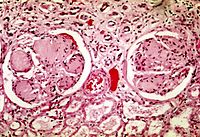
Photo from wikipedia
Background To investigate the prevalence and risk factors of diabetic retinopathy (DR) in a Chinese population with type 2 diabetes mellitus (T2DM) in a suburb (Qingpu) of Shanghai, China. Methods… Click to show full abstract
Background To investigate the prevalence and risk factors of diabetic retinopathy (DR) in a Chinese population with type 2 diabetes mellitus (T2DM) in a suburb (Qingpu) of Shanghai, China. Methods A population-based cross-sectional study. A total of 7462 residents with T2DM in Qingpu were enrolled according to the resident health archives from January 2020 to December 2020. Blood and urine samples of the subjects were collected. Disc- and macula-centred retinal images were taken to assess DR. SPSS was used to analyse and investigate the prevalence and risk factors of DR. Results The fundus images of 6380 (85.5%) subjects were of sufficiently good quality for grading. The average (range) age of 6380 subjects was 63.46±7.77 (28–92) years. Six hundred forty-four subjects were diagnosed with DR. The prevalence of DR was 10.1% (95% CI 9.4%-10.8%), with mild, moderate, and severe non-proliferative retinopathy and proliferative retinopathy being 2.1%, 6.3%, 1.3% and 0.4%, respectively. The prevalence of bilateral DR was 6.5%. Higher T2DM duration (OR, 1.057), fasting plasma glucose (OR, 1.063), glycated hemoglobinA1c (OR, 1.269), urea nitrogen (OR, 1.059), and urinary albumin (OR, 1.001) were associated with the higher DR prevalence. Conclusion The prevalence of DR among Chinese adults with T2DM in Qingpu was 10.1%, in which non-proliferative DR was more common. Higher fasting plasma glucose and glycated hemoglobinA1c are well-known risk factors of DR, consistent with the findings in our study. Our study didn’t find the risk between lipid indicators and DR. However, several renal function indicators, like higher urea nitrogen and urinary albumin, were risk factors for DR in this study. Appropriate diagnosis and intervention should be taken in time to prevent and control DR development.
Journal Title: PLoS ONE
Year Published: 2022
Link to full text (if available)
Share on Social Media: Sign Up to like & get
recommendations!